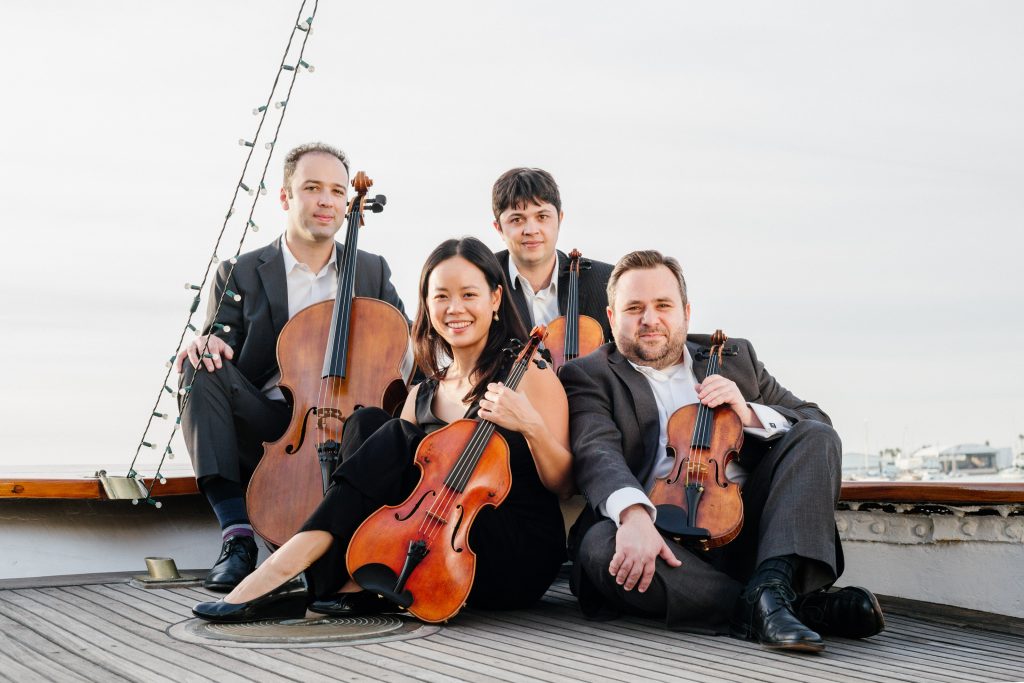Hausmann Quartet Spices Its Recent Haydn Voyage with Caroline Shaw and Terry Riley
The adventurous Hausmann Quartet opened its fifth season of Haydn Voyages on the Berkeley Sunday afternoon (February 9). For some listeners, the adventure of this series is following the quartet’s traversal of the entire output of Joseph Haydn’s 68 string quartets. For this listener, the adventure is discovering the contemporary works Hausmann performs to complement the generous portion of Haydn they perform in each concert.

Hausmann Quartet: (from left) Alex Greenbaum, Angela Choong, Isaac Allen, Bram Goldstein [photo (c.) Samantha Zauscher]
In contrast to Shaw’s focused concision, Terry Riley’s music suggests to me laid-back improvisation, perhaps played under the influence of some mild hallucinogenic. Hausmann offered Riley’s “Good Medicine Dance,” the final movement of an extensive work written in 1987 for the Kronos Quartet: Salome Dances for Peace. In this movement, Riley creates a mood of joyful, slightly hypnotic incantation. He is content for the occasional theme to emerge from his minimalist iterations that echo the harmonic language of Irish fiddle music. In an interview with the music critic Mark Swed, Riley stated that he aimed “to create a piece that can be played at the United Nations on special holidays. It would not be just a concert piece, but a piece that could be played as a rite.”
I don’t know if Salome Dances for Peace ever made it to the U.N., although the Kronos Quartet made a two-disc recording of the work for Nonesuch Records in 1989. Hausmann’s spirited performance of the last movement on Sunday made a compelling case for Riley’s shamanic aspirations, but for this listener, one movement out of the work’s 26 proved sufficient.
For this program, Hausmann chose the first two string quartets from Haydn’s Op. 50, a set of six quartets from 1787. As Hausmann’s resident musicologist Derek Katz explained in his engaging introduction, at this point in Haydn’s career, he and the young Mozart engaged in friendly competition as they challenged each other to produce string quartets of greater complexity and innovation. Op. 50, No. 1 in B-flat major opens like a miniature Haydn symphony, with a stately, slow introduction that breaks into a vigorous Allegro. Haydn’s compositional feat in this movement is making his first theme of the sonata form out of eight consecutive quarter notes on the same pitch. A dull, unpromising idea for even a late 20th-century Minimalist, Haydn nevertheless works musical magic from this unlikely premise.
Typical for his slow quartet movements, Haydn gives the first violin an extended, charming solo, which Isaac Allen’s silvery tone and delicate phrasing turned into a winning cantabile line. Allen and Greenbaum traded motifs with the ease of Chinese ping-pong champions throughout the movement. I admired Hausmann’s effervescent, bravura take on the typical rondo Finale.
For Op. 50, No. 2 in C major, Haydn retrofitted with new themes a similar structure and the same pattern of movements he used for Op. 1 in B-flat major. Minor changes included giving the opening slow movement solo to the second violin, which Bram Goldstein handled capably, and inserting unexpected, middle-of-the-phrase stops in the Menuetto. Musicologist Katz warned the audience seated in the Berkeley of Haydn’s humorous tricks, so no one jumped in with premature applause. But after the finale cadence of the Finale, the audience hesitated ever so slightly to applaud, lest they be caught by trickster Haydn.
This concert was presented by the Hausmann Quartet on February 9, 2020, at the Maritime Museum of San Diego’s ship Berkeley permanently moored on San Diego Bay. The next Haydn Voyage sails on April 19, 2020.
